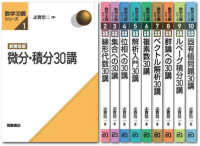- ホーム
- > 洋書
- > ドイツ書
- > Mathematics, Sciences & Technology
- > Technology
- > electronics, electrical engineering, telecommunications
Full Description
This book highlights numerical models as powerful tools for the optimal design of Micro-Electro-Mechanical Systems (MEMS). Most MEMS experts have a background in electronics, where circuit models or behavioral models (i.e. lumped-parameter models) of devices are preferred to field models. This is certainly convenient in terms of preliminary design, e.g. in the prototyping stage. However, design optimization should also take into account fine-sizing effects on device behavior and therefore be based on distributed-parameter models, such as finite-element models. The book shows how the combination of automated optimal design and field-based models can produce powerful design toolboxes for MEMS. It especially focuses on illustrating theoretical concepts with practical examples, fostering comprehension through a problem-solving approach. By comparing the results obtained using different methods, readers will learn to identify their respective strengths and weaknesses. In addition, special emphasis is given to evolutionary computing and nature-inspired optimization strategies, the effectiveness of which has already been amply demonstrated. Given its scope, the book provides PhD students, researchers and professionals in the area of computer-aided analysis with a comprehensive, yet concise and practice-oriented guide to MEMS design and optimization. To benefit most from the book, readers should have a basic grasp of electromagnetism, vector analysis and numerical methods.
Contents
Introduction.- MEMS modelling: distributed vs lumped parameter models.- Engineering electrostatics and boundary-value problems.- Engineering magnetostatics and boundary-value problems.- Steady-conduction field and boundary-value problems.








